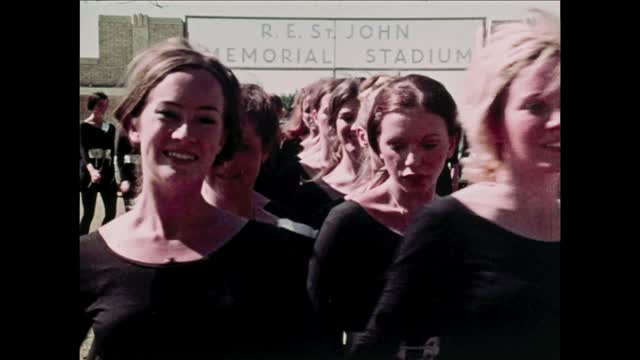
Image credit: videos.videopress.com
The Harry Ransom Center’s current exhibit “Radical Transformation: Magnum Photos into the Digital Age” poses interesting questions about the ambiguity of the photographic medium in our present time, while simultaneously calling into question the status of the photographer as objective.
On my first trip to the exhibit, I am slowly working my way from the exterior towards the interior when I notice a persistent noise in the background – it seems to be the sound of women screaming, and what emotion they signify seems inflected by whatever photographs I look at.
When I first notice the screams I’m looking at Raymond Depardon’s gelatin silver prints from the 1978 series Afghanistan, which documents the lives of the Mujahideen in the Nouristan Mountains of the Badakhstan region. The most visually striking image is “Gathering of Mujahideen.” In steep mountains, by a large stream, men stand wearing hats in a close-knit circle around two men in the center. It evokes feelings of peace. It’s simply titled “Gathering of Mujahideen.” In another image, the same Mujahideen rebels move about in the rubble of a house. The caption states that it has been bombed by the Afghan army.
Still the screams continue. Following associational logic, I imagine that they’re the screams of the people whose house was bombed. After Depardon’s series, however, come celebrities. Magnum is an agency, and photographers live varied lives. Magnum photographer Robert Capa served as a wartime photographer, but later gained many important connections in Hollywood, arranging for the Magnum agency to cover publicity events, including the set of Marilyn Monroe and Clark Gable’s 1960 film, The Misfits. In an effort to make photography competitive with the rising popularity of film, Capa even launched a special documentary unit, Magnum films, which ran from 1964 to 1970.
Moving a few feet to the right, one sees more of these celebrity photos: David Hurn’s images from the series he did on the Beatles, Hard Day’s Night (1964). An image of young women pressed against the windows of Paul McCartney’s train window as he placidly eats breakfast. Suddenly the screams seem reminiscent of “Beatlemania.”I hear two women talking to each other on the other side of the wall “she deserved it,” one says.
I turned the corner and find the voices: two women inside the alcove, watching. The video, a plaque on the wall says, is titled “Beauty Knows No pain.” It’s a 1971 film by Elliott Erwitt, a French-born American member of Magnum. One of the women casts a conspiratorial look, smiles at me while nodding towards the screen and says “painful.” They seem to sense I’m observing them, and maybe want me to know: watching does not indicate endorsing. I walk away and come back later. This time younger girls are in the alcove; they seem more invested. “What are they called? Flag team?” Another girl authoritatively tells her “color guard.” I make a note to myself that maybe these girls are in color guard.
A work of art like this, delivered so matter-of-factly alongside images of famine, and warfare, and disease, makes them seem somehow hyper-trivial at best, and insidious, at worst. But who is making that connection? I accept that it’s me.
I find out, eventually, that the women are actually Kilgore Rangerettes, a world-renowned drill team which began in Texas in 1940. Though the first group of viewers reasonably found the outdated attitudes in the film humorous, the goal of the Rangerettes was originally to provide a physical education that would be of equal quality to men’s, something universities across the globe have yet to achieve – so, how outdated is it really? Because of the total lack of narration, I arrive at the piece of art from multiple angles, always with loose threads to follow up on – also always contingent upon the crowd I am with.
The Magnum collection is in many ways about what fraught cross-purposes photographers are at: juggling their roles as detached observers on the one hand, and members of specific ideological and cultural communities, on the other. I think of the first two women who wanted me to know that observation didn’t imply complicity. A conversation about objectivity and the participation of viewer and photographer in the art experience runs throughout the Magnum exhibit. Projects like Magnum’s “Postcards from America,” also featured in the gallery space, explore this tension between observing and narrating. To this end, the Magnum collection is a meditation on what it means to make photos, but also, to be a viewer of them.
Recent comments
2 years 29 weeks ago
2 years 44 weeks ago
2 years 44 weeks ago
2 years 50 weeks ago
3 years 4 weeks ago
3 years 4 weeks ago
3 years 4 weeks ago
3 years 6 weeks ago
3 years 6 weeks ago
3 years 6 weeks ago